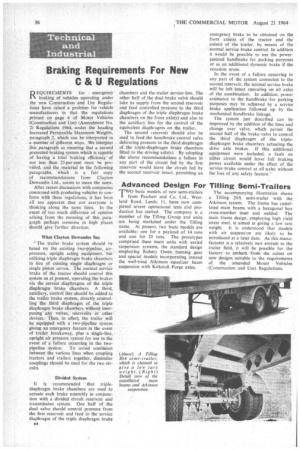Braking Requirements For New C & U Regulations
Page 40

If you've noticed an error in this article please click here to report it so we can fix it.
REQU1REMENTS for emergency braking of vehicles operating under the new Construction and Use Regulations have raised a problem for vehicle manufacturers in that the regulations printed on page 6 of Motor Vehicles (Construction and Use) (Amendment No. 2) Regulations 1964, under the heading Increased Permissible Maximum Weights, paragraph 2, which can be interpreted in a number of different ways. We interpret this paragraph as meaning that a second .protected braking system which is capable of having a total braking efficiency of not less than 25 per cent must he provided, and the material in the following paragraphs, which is a fair copy of recommendations from Clayton Dewandre Ltd., seems to mean the same.
After recent discussions with companies concerned with producing vehicles to conform with these regulations, it has been all too apparent that not everyone is thinking along the same 'lines, In the event of too much difference of opinion arising from the meaning of this paragraph perhaps someone in high places should give further direction.
What Clayton Dewandre Say The trailer brake system -should he based on the existing two-pipeline, airpressure, upright acting equipment, but utilizing triple diaphragm brake chambers in lieu of existing single diaphragm or single piston servos. The normal service brake of the tractor should control this system as at present, operating the brakes via the service diaphragms of the triple diaphragm brake chambers. A third, auxiliary, control line should be added to the trailer brake system, directly controlling the third diaphragm of the triple diaphragm brake chambers without interposing any valves, • reservoirs or other devices. Then, in effect, the trailer will be equipped with a two-pipeline system giving an emergency feature in the event of trailer breakaway, plus a single-line, upright air pressure system for use in the event of a failure occurring in the twopipeline system. To avoid confasion between the various lines when coupling tractors and trailers together, dissimilar couplings should be used for the two circuits.
Divided System It is recommended that triplediaphragm brake chambers are used to actuate each brake assembly in conjunction with a divided circuit reservoir and transmission system. One half of the dual valve should control pressure from the first reservoir and feed to the service diaphragm of the triple diaphragm brake B4 chambers and the trailer service line, The other half of the dual brake va1vB should take its supply from the second reservoir and feed controlled pressure to the third diaphragm of the triple diaphragm brake chambers on the front axle(s) and also to the auxiliary line for the control of the equivalent diaphragms on the trailer.
The second teservoir should also be used to feed the handbrake control valve delivering pressure to the third diaphragm of the triple-diaphragm brake chambers fitted to the driving axle(s). By adopting the above recommendations a failure in any part of the circuit fed by the first reservoir would leave the circuit fed by the second reservoir intact, permitting an emergency brake to be obtained on the front axle(s) of the tractor and the axle(s) of the trailer, by means of the normal service brake control. In addition it would be possible to use the powerassisted handbrake for parking purposes or as an additional dynamic brake if the occasion arose.
In the event of a failure occurring in any part of the system connected to the second reservoir, the normal service brake will be left intact operating on all axles of the combination. In addition, power assistance to the handbrake for parking purposes may be achieved by a service brake application followed up by the mechanical handbrake linkage.
The system just described can be improved by the addition of the lines and change over valve, which permit the second half of the brake valve to control • the third diaphragm of the triplediaphragm brake chambers actuating the drive axle brakes. If this additional equipment were included, a fault on either circuit would leave full braking power available under the effect of the service brake control at all 'axles without the loss of any safety feature."






















































































































